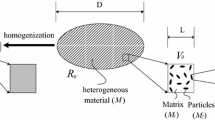Abstract
In Xu et al. (Comput Struct 87:1416–1426, 2009) a novel Green-function-based multiscale stochastic finite element method (MSFEM) was proposed to model boundary value problems involving random heterogeneous materials. In this paper, we describe in detail computational aspects of the MSFEM explicitly across macro–meso–micro scales. Different numerical algorithms are introduced and compared in terms of numerical accuracy and convergence.
Similar content being viewed by others
References
Adams RA (1975) Sobolev spaces. Academic Press, New York
Bensoussan A, Lions L, Papanicolaou G (1978) Asymptotic analysis for periodic structures. North-Holland, Amsterdam
Charmpis DC, Schueller GI, Pellissetti MF (2007) The need for linking micromechaincs of materials with stochastic finite elements: a challenge for material science. Comput Mater Sci 41: 27–37
Chen JS, Mehraeen S (2005) Multi-scale modeling of heterogeneous materials with fixed and evolving microstructures. Model Simul Mater Sci Eng 13: 95–121
Der Kiureghian A, Ke JB (1988) The stochastic finite element method in structural reliability. Probab Eng Mech 3: 83–91
Fish J, Chen W (2004) Discrete-to-continuum bridging based on multigrid principles. Comput Methods Appl Mech Eng 193: 1693–1711
Ghosh S, Bai J, Raghavan P (2007) Concurrent multi-level models for damage evolution in microstructurally debonding composites. Mech Mater 39: 241–266
Ghosh S, Lee K, Moorthy S (1996) Two scale analysis of heterogeneous elastic-plastic materials with asymptotic homogenization and voronoi cell finite element model. Comput Methods Appl Mech Eng 132(1–2): 63–116
Guidault PA, Allix O, Champaney L, Navarro JP (2007) A two-scale approach with homogenization for the computation of cracked structures. Comput Struct 85(17–18): 1360–1371
Halpin JC, Kardos JL (1976) Halpin-Tsai equations: a review. Polym Eng Sci 16(5): 344–352
Hashin Z, Shtrikman S (1963) A variational approach to the theory of the elastic behavior of multiphase materials. J Mech Phys Solids 11: 127–140
Hutchinson JW, Evans AG (2000) Mechanics of materials: top-down approaches to fracture. Acta Mater 48: 125–135
Ibrahimbegovic A, Markovic D (2003) Strong coupling methods in multi-phase and multi-scale modeling of inelastic behavior of heterogeneous structures. Comput Methods Appl Mech Eng 192: 3089–3107
Kaminński M (2006) On generalized stochastic perturbation-based finite element method. Commun Numer Methods Eng 22(1): 23–31
Kanit T, Forest S, Galliet I, Mounoury V, Jeulin D (2003) Determination of the size of the representative volume element for random composites: statistical and numerical approach. Int J Solids Struct 40(13–14): 3647–3679
Kouznetsova V, Brekelmans WAM, Baaijens FPT (2001) An approach to micro-macro modeling of heterogeneous materials. Comput Mech 27: 37–48
Kröner E (1972) Statistical continuum mechanics. Springer-Verlag, Wien
Ladeveze P (2004) Multiscale modeling and computational strategies for composites. Int J Numer Methods Eng 60: 233–253
Liu WK, McVeigh C (2008) Predictive multiscale theory for design of heterogeneous materials. Comput Mech 42(2): 147–170
Miehe C, Bayreuther CG (2007) On multiscale FE analyses of heterogeneous structures: from homogenization to multigrid solvers. Int J Numer Methods Eng 71(10): 1135–1180
Milton GW (2002) The theory of composites. Cambridge University Press, Cambridge
Nemat-Nasser S, Hori M (1999) Micromechanics: overall properties of heterogeneous materials. North-Holland, Amsterdam
Oden JT, Vemaganti KS (2000) Estimation of local modeling error and goal-oriented adaptive modeling of heterogeneous materials I: error estimates and adaptive algorithms. J Comput Phys 164: 22
Ostoja-Starzewski M, Du X, Khisaeva Z, Li W (2007) Comparisons of the size of representative volume element in elastic, plastic, thermoelastic, and permeable random microstructures. Int J Multiscale Comput Eng 5(2): 73–82
Pindera MJ, Aboudi J, Arnold SM (1995) Limitations of the uncoupled, RVE-based micromechanical approach in the analysis of functionally graded composites. Mech Mater 20: 77–94
Sanchez-Palencia E (1980) Nonhomogeneous media and vibration theory. Lecture Notes in Physics, vol 127. Springer, Berlin
Vanmarcke EH, Grigoriu M (1983) Stochastic finite element analysis of simple beams. J Eng Mech ASCE 109: 1203–1214
E W, Engquist B, Li X, Ren W, Vanden-Eijnden E (2007) Heterogeneous multiscale methods: a review. Comput Phys Commun 2(3): 367–450
Weng GJ (1990) The theoretical connection between Mori- Tanaka’s theory and the Hashin-Shtrikman-Walpole bounds. Int J Eng Sci 28: 1111–1120
Xu XF (2007) A multiscale stochastic finite element method on elliptic problems involving uncertainties. Comput Methods Appl Mech Eng 196(25–28): 2723–2736
Xu XF (2009) Generalized variational principles for uncertainty quantification of boundary value problems of random heterogeneous materials. ASCE J Eng Mech 135(10): 1180–1188
Xu XF, Chen X (2009) Stochastic homogenization of random multi-phase composites and size quantification of representative volume element. Mech Mater 41(2): 174–186
Xu XF, Chen X, Shen L (2009) A Green-function-based multiscale method for uncertainty quantification of finite body heterogeneous materials. Comput Struct 87: 1416–1426
Zohdi TI, Wriggers P (2001) A model for simulating the deterioration of structural-scale material responses of microheterogeneous solids. Comput Methods Appl Mech Eng 190: 2803–2823
Zohdi TI, Wriggers P (2008) An introduction to computational micromechanics. Springer-Verlag, New York
Author information
Authors and Affiliations
Corresponding author
Rights and permissions
About this article
Cite this article
Shen, L., Xu, X.F. Multiscale stochastic finite element modeling of random elastic heterogeneous materials. Comput Mech 45, 607–621 (2010). https://doi.org/10.1007/s00466-010-0474-4
Received:
Accepted:
Published:
Issue Date:
DOI: https://doi.org/10.1007/s00466-010-0474-4



